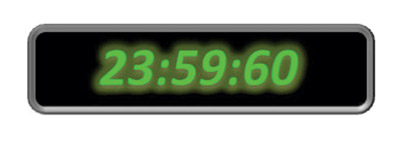Tabled decision gains time for leap seconds
DOI: 10.1063/PT.3.1471
A US-led proposal to do away with leap seconds proved contentious enough for the radiocommunication sector of the International Telecommunication Union (ITU-R) to decide, at its January meeting in Geneva, to postpone any decision until 2015.
Leap seconds are inserted periodically to sync time as determined from Earth’s rotation with time as measured by atomic clocks. Such clocks follow the international definition of the second: 9 192 631 770 periods of the quantum transition between two hyperfine ground-state levels of cesium-133.
The International Bureau of Weights and Measures in France uses information from hundreds of atomic clocks around the world to set Coordinated Universal Time (UTC); the International Earth Rotation and Reference Systems Service gives about six months’ notice when a leap second will be added to keep the two times within 0.9 second of each other. Leap seconds are inserted on the last day of June or December just before midnight UTC—in the middle of the night in Europe, in the evening on the US East Coast, and during daytime business hours around the Pacific. The next leap second will be added on 30 June.
Since the first leap second 40 years ago—five years after adoption of the cesium time standard—one has been inserted on average every 18 months to make up for Earth’s slowing rotation due to such things as exchanges of angular momentum in the Earth–Moon system, interactions between Earth’s core and mantle, and large-scale weather patterns like El Niño. More frequent leap seconds are expected to be required in the future. (See the Quick Study in PHYSICS TODAY, November 2006, page 78
Astronomers vs. programmers
To a great extent, the leap-second debate pits astronomers against computer jocks, notes Richard Langley, who works on global navigation satellite systems at the University of New Brunswick. “For many purposes, this whole discussion is esoteric,” says Rob Seaman, a software systems engineer at the National Optical Astronomy Observatory in Arizona: If Earth rotation time is disconnected from atomic time, it would be many millennia before night would turn to day. “But for astronomy and aerospace, [the disconnect] would become obvious quickly.” One second of Earth’s rotation corresponds to 15 seconds of arc on the sky; the full Moon is 1800 arcseconds across. Abandoning leap seconds, Seaman says, “will cost the astronomical community and various aerospace communities a lot of time and money to fix systems that are not currently broken.”
Poul-Henning Kamp, an authority on UNIX and other computer systems and a self-employed programmer in Denmark, got involved in the debate when he worked on air traffic control systems. “A modern plane moves 1000 feet in one second,” he says. “Suddenly leap seconds had a meaning. We have to fix software.”
For air traffic control, financial transactions, assembly lines, and other computer-controlled processes, inserting a second can disrupt operations. Some assembly processes shut down—and may thereby lose money—to avoid problems, notes Kamp. Fundamentally, he says, “getting rid of leap seconds is an economic question.”
Would it cost more to keep leap seconds or to drop them? Steve Allen, a programmer at the University of California’s Lick Observatory, estimates that dropping leap seconds would cost the observatory about two person-years of effort. “It’s a hunt for possible problems with software and hardware and procedures of telescope operations. It’s a lot like the Y2K bug,” he says. Either way, “many man-years of effort will be expended. There is no getting around that,” says Allen, who with Seaman helped organize a conference last fall to discuss implications of abandoning leap seconds (see http://futureofutc.org
Assessing the implications
At the ITU-R meeting, countries were closely split in favor of, against, and undecided about abolishing leap seconds, with many of the undecided ones saying they were not well enough informed to vote on the proposal. Keeping Earth time and atomic time coordinated has legal, philosophical, financial, and political implications. The UK, for example, which wants to keep leap seconds, has a historic relationship to Greenwich Mean Time, for which UTC is a close approximation. Other countries that wanted to retain leap seconds included Canada, China, and Germany. France, Italy, Japan, South Korea, and Mexico were among those joining the US in preferring to abolish them.
Abolishing leap seconds would have “monumental implications,” says David Finkleman of the Center for Space Standards and Innovation, the research arm of Analytical Graphics Inc. Before the ITU-R meets to consider doing so, “we need a more comprehensive and inclusive assessment of the problems people have, why they have them, and how and if they can be fixed.”
In Allen’s view, both sides in the debate over leap seconds exhibit “the technical equivalent of psychological denial. There are a lot of people who are not recognizing the big picture.”

Adding an extra second to a day to sync Earth rotation time with atomic time can trip up software systems. But abolishing such leap seconds carries costs too.

More about the Authors
Toni Feder. tfeder@aip.org





